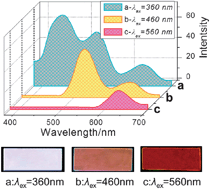Multi-color emission materials (especially white light) have broad applications in optoelectronics, light-emitting diodes (LEDs) and optical devices. This work describes the fabrication of multicolor and white-light-emitting ultrathin films (UTFs) with 2D architecture based on CdTe quantum dots (QDs: red or green emission), an organic chromophore (BTBS: blue emission) and MgAl layered double hydroxide (LDH) nanosheets via the layer-by-layer assembly method. The hybrid UTFs possess a periodic long-range ordered layered structure, which is verified by X-ray diffraction. By rational selection of the building unit and control of the assembly sequence, the luminescence color of the resulting UTFs can be precisely tuned throughout the whole visible-light region. Especially, finely controlled white-light emission was successfully achieved with the color coordinates at (0.322, 0.324), rather close to the standard coordinates of white light (0.333, 0.333). In addition, the QDs–BTBS–LDH UTF displays intelligent photoluminescence behavior, i.e., white, orange, or red emission can be obtained for the same UTF by changing the excitation light. Therefore, this work provides a facile approach for accurate fabrication of multi-color/white-light photoemission UTFs, which is expected to be used in full-color displays, sensing and intelligent response.


 Please wait while we load your content...
Please wait while we load your content...